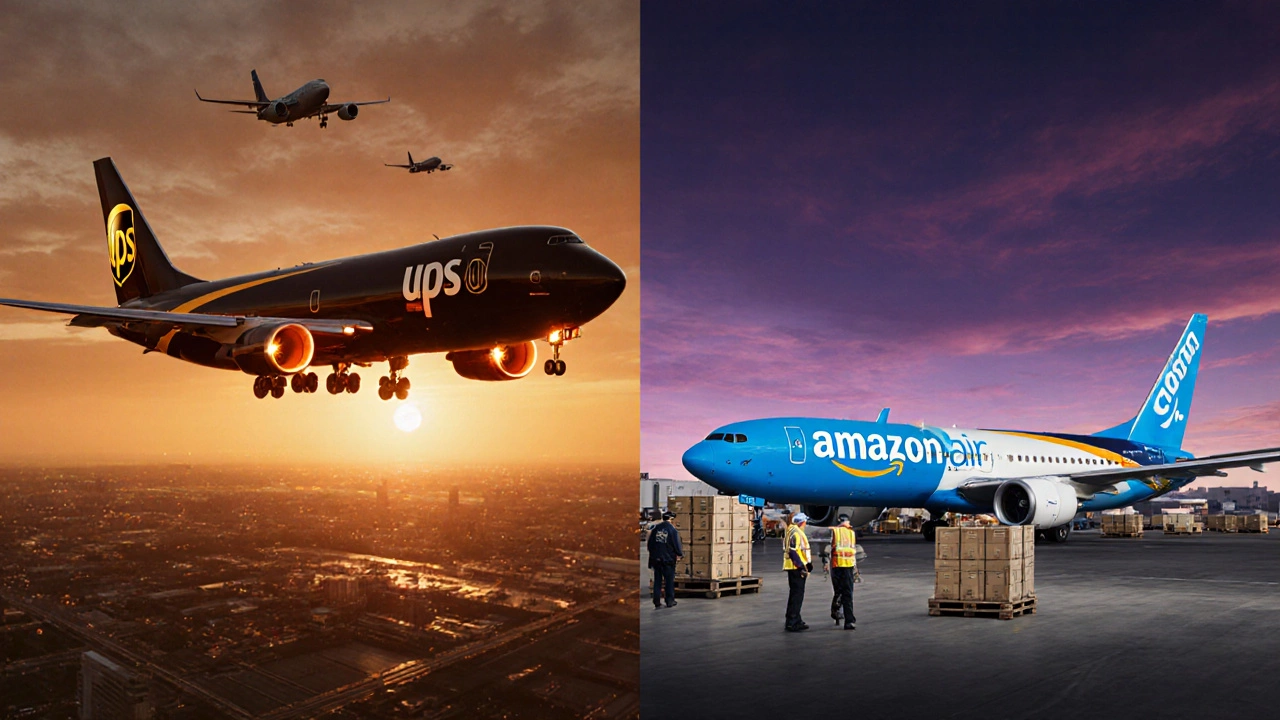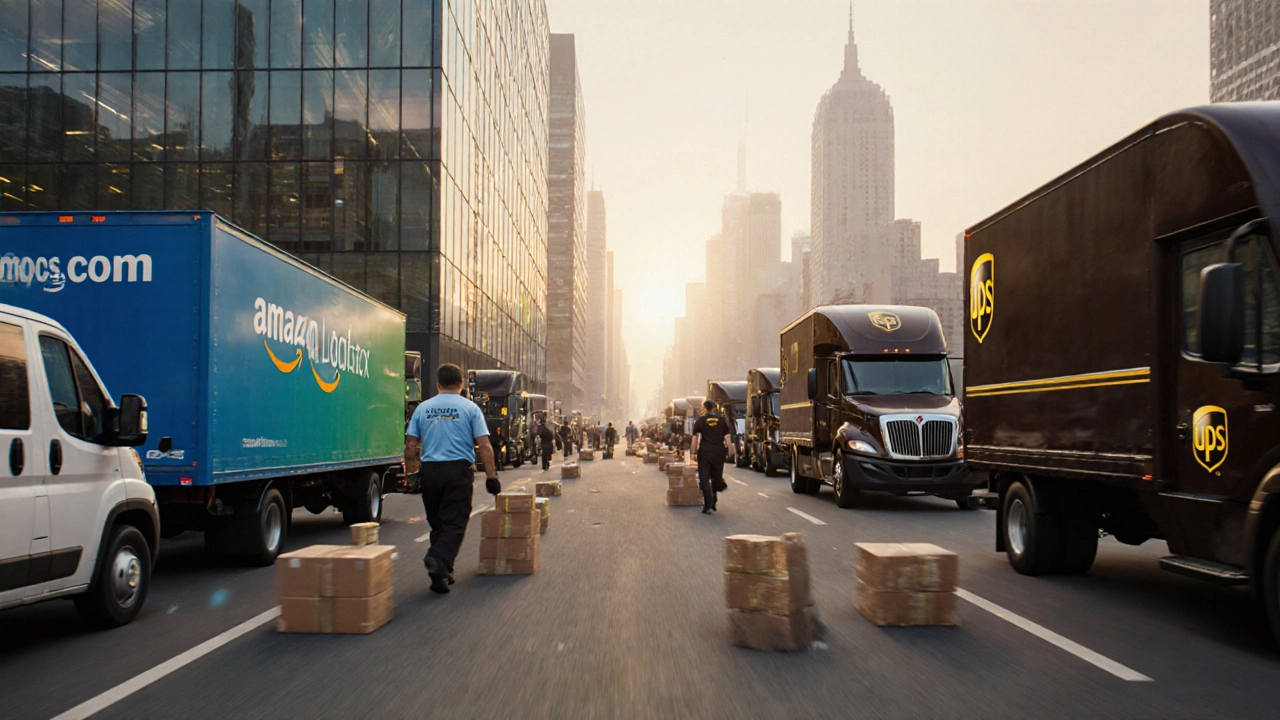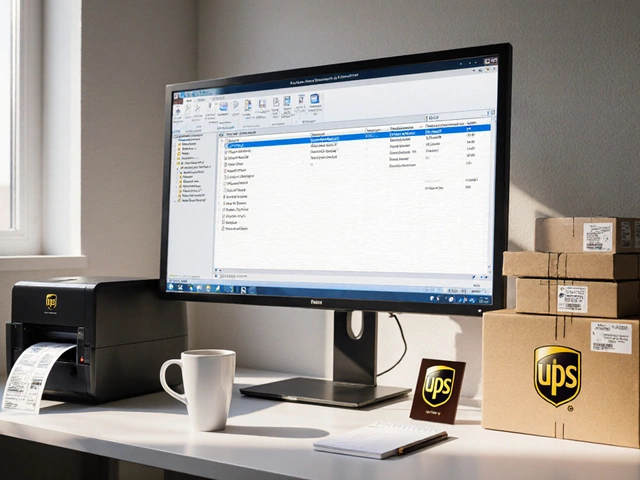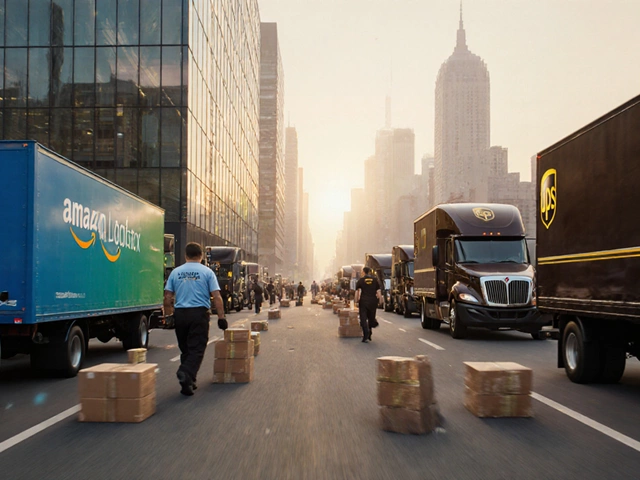Logistics Network Comparison Calculator
Which Logistics Network Suits You Best?
Select your priority metric to see how Amazon Logistics and UPS compare. Based on 2024 data from the article.
Select Metric
Annual Revenue Comparison
When you ask whether Amazon logistics is bigger than UPS, the answer isn’t simple. Both giants run massive operations, but they measure size in different ways-revenue, package volume, fleet size, global footprint, and technology investment. Let’s break down the numbers, the infrastructure, and the strategic moves that define each powerhouse.
What Is Amazon Logistics?
Amazon Logistics is the delivery and fulfillment arm of Amazon.com, handling everything from same‑day orders to long‑haul freight. Launched in 2015, it has grown into a multimodal network that includes ground trucks, air cargo, and a growing fleet of electric delivery vans. Its core mission is to shrink the distance between Amazon’s massive catalog and the customer’s doorstep.
What Is UPS?
United Parcel Service (UPS) is a global package delivery and supply‑chain management company founded in 1907. With a brand built on reliability, UPS operates a fully integrated system that covers everything from small parcels to heavyweight freight, spanning over 220 countries and territories.
Key Scale Metrics - 2024 Snapshot
To compare size, we need a common set of metrics. Below is a side‑by‑side view of the most telling figures for both companies.
| Metric | Amazon Logistics | UPS |
|---|---|---|
| Annual Revenue (Logistics segment) | $125billion | $106billion |
| Packages Delivered | ≈ 5.5billion | ≈ 5.2billion |
| Fleet Size (Ground Vehicles) | ≈ 125,000 trucks & vans | ≈ 125,000 trucks & vans |
| Air Cargo Capacity | 250aircraft (owned + leased) | 400+ aircraft (including cargo airlines) |
| Fulfillment Centers | ≈ 200 worldwide | ≈ 75 UPS‑owned facilities + 200 third‑party hubs |
| Employees in Logistics | ≈ 530,000 | ≈ 450,000 |
| Countries Served | ≈ 200 (directly via Amazon Logistics) | 220+ |
The numbers show a nuanced picture. Amazon’s logistics arm outpaces UPS in revenue and package volume, thanks largely to the sheer scale of Amazon’s e‑commerce platform. UPS still holds a larger air‑cargo fleet, a legacy advantage that gives it reach for heavyweight and international freight.

Ground Fleet and Last‑Mile Delivery
Both companies operate roughly the same number of ground vehicles, but they differ in ownership and deployment strategies. Amazon Logistics heavily relies on independent contractors through its Amazon Flex program, which adds flexibility during peak seasons. UPS, on the other hand, maintains a larger proportion of company‑owned trucks, providing tighter control over service standards. The hybrid model lets Amazon scale quickly, while UPS benefits from a more consistent driver experience.
Air Cargo and International Reach
UPS’s air network remains the larger of the two. UPS Airlines operates a dedicated fleet of over 400 aircraft, complemented by partnerships with global carriers. Amazon has been expanding its air capability through Amazon Air, now operating a fleet of Boeing 767‑300F and 737‑800BCF aircraft, plus a growing number of leased jets. While Amazon’s air capacity is rising fast, UPS still commands the broader international air‑freight market, especially for cross‑border shipments that require customs brokerage.
Fulfillment Centers and Warehousing Muscle
Amazon’s backbone is its network of fulfillment centers, often called “fulfillment hubs.” Amazon fulfillment centers average 1million square feet, equipped with automated conveyor belts, Kiva robots, and AI‑driven inventory systems. UPS leverages a mix of its own facilities and a vast ecosystem of third‑party logistics (3PL) partners. The sheer number of Amazon‑owned sites gives it a direct line from inventory to the truck, shaving hours off delivery times.
Technology Edge and Automation
Both players invest heavily in tech, but their focus diverges. Amazon treats logistics as a data engine: real‑time routing algorithms, predictive stocking, and a massive AI infrastructure that forecasts demand down to the zip code. UPS, meanwhile, champions its ORION (On‑Road Integrated Optimization and Navigation) system, which optimizes driver routes to save millions of miles each year. In the automation arena, Amazon leads with warehouse robotics, while UPS has been testing autonomous delivery vehicles and drone trials for remote locations.

Financial Muscle and Profitability
Revenue alone doesn’t paint the whole profitability picture. Amazon’s logistics costs are largely absorbed into its broader e‑commerce margins, allowing it to reinvest in infrastructure without immediate profit pressure. UPS reports a logistics segment operating margin of around 9%, reflecting a mature, price‑sensitive market. Amazon’s logistics arm is still in a growth phase, with operating losses offset by the strategic value of faster delivery for its core retail business.
Strategic Implications for Shippers and Consumers
If you are a retailer deciding between the two, consider your priorities. Amazon offers unparalleled speed and integration for sellers on its marketplace, but you surrender control over branding and data. UPS provides a neutral carrier with extensive global customs expertise, making it a safer bet for multi‑channel sellers needing consistent service across regions.
For consumers, Amazon’s presence means more free two‑day or same‑day options, especially for Prime members. UPS still dominates in areas where Amazon lacks a local hub, such as rural or international destinations not covered by Amazon’s own network.
Quick Takeaways
- Revenue & Package Volume: Amazon Logistics leads.
- Air Cargo Capacity: UPS still larger.
- Ground Fleet Size: Roughly equal, but Amazon leans on contractors.
- Fulfillment Centers: Amazon’s network is deeper and more automated.
- Global Reach: UPS edges out in full‑service international freight.
- Technology: Both are innovators; Amazon focuses on AI‑driven inventory, UPS on route optimization.
Frequently Asked Questions
Is Amazon Logistics a separate company from Amazon?
No. Amazon Logistics is an internal division of Amazon.com that handles the company’s own deliveries and, increasingly, offers third‑party shipping services.
How many packages does UPS deliver each year?
UPS moves roughly 5.2billion packages worldwide annually, according to its 2024 annual report.
Can I ship internationally with Amazon Logistics?
Amazon now offers international delivery to over 200 countries, but the service is mainly tied to Amazon Marketplace orders. Independent shippers still rely on traditional carriers like UPS for broader customs support.
Which company has a greener fleet?
Both are investing heavily in electric vehicles. UPS announced a goal of 2,500 electric trucks by 2025, while Amazon’s Climate Pledge Fund backs the rollout of 100,000 electric delivery vans over the next decade.
What’s the biggest advantage of using UPS over Amazon Logistics?
UPS offers a neutral, globally recognized carrier with deep customs expertise, making it ideal for businesses that ship a wide range of products across many markets.





